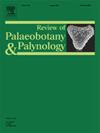Potential and limitations of New Zealand's pre-deforestation fossil pollen records as recent analogues in palaeoecological research
IF 1.7
3区 地球科学
Q2 PALEONTOLOGY
引用次数: 0
Abstract
Modern pollen analogues act as reference samples (calibration datasets), representing the observable range of vegetation types and their climatic drivers. However, in some areas, human activities have decoupled vegetation-climate relationships, resulting in modern pollen spectra that do not accurately represent those processes and are poor analogues to fossil pollen. Where these issues arise, recent fossil pollen may be an appropriate substitute. This approach is particularly relevant in New Zealand, where indigenous forest cover has been radically reduced from 85 – 90% to 25% over c. 750 years, leaving deforested areas where modern pollen samples are overwhelmed by anthropogenic signals. The point in time just prior to human arrival in New Zealand (c. CE 1280), is therefore an essential reference point for building representative calibration datasets and accurate palaeoecological reconstructions. In this review, we took a systematic quantitative approach to (1) compile a site inventory of New Zealand's pre-deforestation fossil pollen datasets from published literature (including theses), (2) identify biases and gaps in their spatial distribution (geography, climate, remaining vegetation, and potential vegetation) and describe their influence on the accuracy of future analogue-based research, and (3) comment on the availability of datasets in existing palaeoecological archives. We identified 275 datasets across New Zealand and – while they had an impressive geospatial and climatic range – uncommon vegetation types, cold and dry eastern areas, and forested reference sites were under-represented. Few raw datasets (n = 10) were readily accessible through public data repositories, and we believe New Zealand would benefit from a national palaeoecological database.
新西兰森林砍伐前的花粉化石记录在古生态学研究中的潜力和局限性
现代花粉类似物作为参考样本(校准数据集),代表了植被类型及其气候驱动因素的可观测范围。然而,在一些地区,人类活动使植被与气候的关系脱钩,导致现代花粉谱不能准确地代表这些过程,并且与化石花粉的相似度很差。在这些问题出现的地方,最近的化石花粉可能是合适的替代品。这种方法在新西兰尤其适用,在新西兰,原生森林覆盖率在750年的时间里从85 - 90%急剧减少到25%,留下了现代花粉样本被人为信号淹没的森林砍伐地区。因此,人类到达新西兰之前的时间点(约公元1280年)是建立具有代表性的校准数据集和准确的古生态重建的重要参考点。在这篇综述中,我们采用了系统的定量方法:(1)从已发表的文献(包括论文)中编制新西兰森林砍伐前化石花粉数据集的站点清单;(2)识别其空间分布(地理、气候、剩余植被和潜在植被)中的偏差和差距,并描述它们对未来基于模拟的研究准确性的影响;(3)对现有古生态档案中数据集的可用性进行评论。我们确定了新西兰各地的275个数据集,尽管它们具有令人印象深刻的地理空间和气候范围,但罕见的植被类型、寒冷干燥的东部地区和森林参考地点的代表性不足。很少有原始数据集(n = 10)可以通过公共数据库轻松访问,我们相信新西兰将从国家古生态数据库中受益。
本文章由计算机程序翻译,如有差异,请以英文原文为准。
求助全文
约1分钟内获得全文
求助全文
来源期刊
CiteScore
3.50
自引率
21.10%
发文量
149
审稿时长
6 months
期刊介绍:
The Review of Palaeobotany and Palynology is an international journal for articles in all fields of palaeobotany and palynology dealing with all groups, ranging from marine palynomorphs to higher land plants. Original contributions and comprehensive review papers should appeal to an international audience. Typical topics include but are not restricted to systematics, evolution, palaeobiology, palaeoecology, biostratigraphy, biochronology, palaeoclimatology, paleogeography, taphonomy, palaeoenvironmental reconstructions, vegetation history, and practical applications of palaeobotany and palynology, e.g. in coal and petroleum geology and archaeology. The journal especially encourages the publication of articles in which palaeobotany and palynology are applied for solving fundamental geological and biological problems as well as innovative and interdisciplinary approaches.

 求助内容:
求助内容: 应助结果提醒方式:
应助结果提醒方式:


